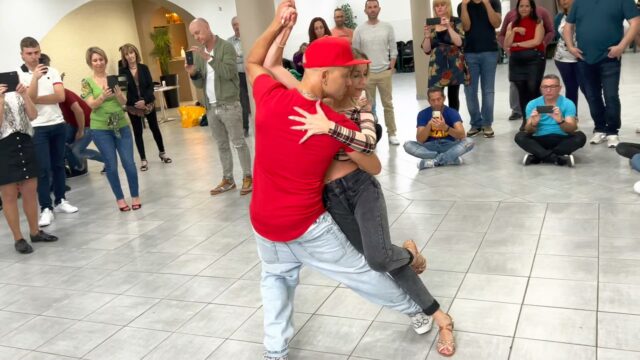Kizomba is an intimate, sensual partner dance that originated in Angola. With such close body contact, it’s natural to wonder what boundaries should exist between dance partners. So let’s explore some perspectives on appropriate closeness in kizomba. To do so I would like you to take a look at this video of Ben and Ana first:

When Ben and Ana are dancing, there is not much physical contact between their bodies. However there is a lot of emotional closeness. They are a perfect example of how to dance kizomba without the signature chest-to-chest embrace, yet maintain intimacy and connection. In fact most of the figures used by Ben require some distance between the partners, while others can be danced really close. But just how close is too close?
- Kizomba Meets Tango: Ben & Ana’s Masterful Workshop Demo
- Sara Lopez & Ivo Vieira: Captivating Kizomba to African Woman
- How Difficult is Kizomba to Learn?
Defining Closeness
When discussing closeness in partner dancing, we refer to two key factors:
- Physical proximity – The distance between dancers’ bodies and intimacy of contact points
- Emotional intimacy – The interpersonal connection and chemistry between partners
Both can impact perceptions of appropriate boundaries.
Kizomba requires chest-to-chest connection and full-body contact. Partners stay in a closed position, with the leader’s right hand on the follower’s back and left hand holding the follower’s right hand. However, the way dancers interact within this close embrace can vary drastically as you saw in our today’s video.
Comfort Levels
First thing to remember – perceptions on spatial closeness differ greatly. Every dancer has different comfort thresholds for closeness while dancing. Numerous personal factors influence this: cultural background, gender, relationship status, boundaries with touch and previous dance experience.
While kizomba traditionally involves snug hold and hip motion, that doesn’t mean all movements or contact points are acceptable to each partner. Navigating comfort zones is key.
Signs of “Too Close”
When dancing, pay attention to your partner’s signals. If they pull back slightly, take it as a cue to create some distance. Don’t force nearness if your partner seems reluctant.
How can you tell if you’ve surpassed your dance partner’s acceptable closeness? Warning signs may include:
- Pulling away or tension in embrace
- Hesitation responding to lead
- Verbal/nonverbal cues of discomfort
- Attempts to widen distance between bodies
Paying attention to these negative reactions, and respecting when a partner directly states boundaries, keeps the dance consensual. Of course these signs may also indicate at your partner anxiety not related to your way of dancing, especially if he or she is a beginner dancer.
However the most obvious things to watch out for and to avoid are:
- Unwelcome lingering touches
- Invasion of intimate zones (chest, thighs)
- Sexually suggestive hip motion or grinding
Most importantly, if you are on the receiving end of such forced intimacy – never sacrifice comfort for the sake of dance technique or aesthetics. No dance is worth enduring unwanted proximity or touch.
Best Practices
Here are some best practices for maintaining appropriate closeness:
- Lead and Follow Subtly: Initiate moves gradually so partner can follow comfortably. Focus lead/follow on core, not over-directing limbs.
- Prioritize Emotional Connection: Make eye contact and communicate through gaze. Express the music emotionally, not just physically.
- Use Appropriate Hand Placement: Keep hands in neutral zones (mid-back, hands, shoulders). Avoid resting hands on waist, hips, or wandering ambiguously.
- Match Hip Motion to Partner’s Comfort: Start small, establish agreement, then build/vary incrementally. If in doubt, ease up on hips presses and body rolls.
In Summary
Finding the sweet spot of closeness in kizomba is an ongoing dialogue between partners requiring mutual care, attention and respect. Don’t make assumptions. The best dancers respond to subtle signals, adjust techniques to align with the follower, and develop the sensitivity to move as one – maintaining a profound connection without crossing interpersonal boundaries.
If you enjoyed this article, feel free share it with your friends and let them know what you think about it. Also, consider checking out our most recent posts and stay in touch. Thank you!





